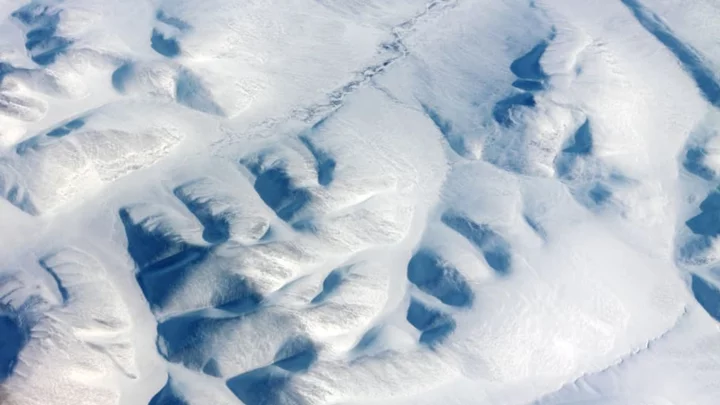Yakutsk, the capital of Russia’s Sakha Republic, is often called the coldest city on the planet. This is for good reason: In winter, temperatures tend to hover around a bone-chilling -58°F. An extreme climate dictates an extreme way of life; residents cannot wear glasses without having them freeze to their faces and, while waiting for the bus, they must huddle up inside heated bus stops or nearby shops to stave off hypothermia.
Such precautions are non-negotiable for people living on permafrost: permanently and perpetually frozen soil found across circumpolar North America, Europe, and Asia. Containing more greenhouse gases than humans could ever produce, not to mention diseases that have been trapped in snow and ice for millennia, there is more to permafrost than meets the eye—so much more that these 10 facts will only scratch the surface.
1. Permafrost covers around 11 percent of the Earth’s surface.
Though scientific descriptions vary from study to study, permafrost is usually defined as ground that stays completely frozen for two or more years. Conventional estimates state the current surface area of the world's permafrost is around 22.8 million square kilometers (8.8 million square miles). For context, that’s about 15 percent of the exposed land surface in the Northern Hemisphere, and 11 percent of Earth’s total surface.
Permafrost is commonly found all throughout the Northern Hemisphere, claiming vast territories in Alaska, Canada, and Russia. Some classifications extend the total area to include the tallest peaks of the Himalayas as well as ice-free land of the Antarctic. If permafrost areas vary in size, they also vary in depth. In some places, frozen soil penetrates to around three feet below the surface. Elsewhere, it’s nearly 5000 feet thick.
2. There are two types of permafrost.
Researchers generally distinguish between two major types of permafrost: continuous and discontinuous. Continuous permafrost is an uninterrupted area of frozen soil stretching from one place to another. One of the largest sections of continuous permafrost in the world, located in the Russian region of Siberia, is rapidly thawing due to climate change.
Discontinuous permafrost, meanwhile, is separated into distinct areas. Some permafrost is broken up by terrain, with snow and ice being preserved in the shadows of mountains but not in the sun. Elsewhere, permafrost is broken up by climate, with parts thawing in the summer and reforming in winter. Discontinuous permafrost can be found in Canada’s Hudson Bay.
3. Thawing permafrost can assume strange, polygonal shapes.
If you thought of permafrost as a flat, featureless landscape, think again. Over centuries and sometimes even decades, melting snow can seep into cracks in the ground, forming shapes that at a glance appear unnatural yet in reality are anything but. These mosaics, which can also be found on drying mud flats, can cover thousands of square miles, with each individual polygon varying from 30 to 100 feet in diameter [PDF].
Because polygonal fields are created by thawing ice, it should come as no surprise that they will show up more often as global warming continues. But polygonal fields are hardly the only manifestation of permafrost erosion. In Alaska, warming ground causes landslides, drains lakes, and forms new depressions filled with thawing ice.
4. Permafrost preserves a variety of prehistoric specimens.
Permafrost areas are rich in flora and fauna. Because the frozen ground is usually covered by a thin layer of wet, non-frozen soil, some species have managed to colonize these inhospitable habitats. Hardy plants like pine, larch, and spruce trees; Arctic willows, saxifrages, and a number of different mosses, grasses, lichens, and sedges have adapted to the extreme cold, wind, and short growing seasons of the polar regions. The more the Earth warms up, however, other plants will be able to migrate north, eventually changing the tundra to woodlands.
Permafrost also preserves a variety of prehistoric plants and animals that used to call the tundra their home. Among the animals found in permafrost include the calves of woolly mammoths and woolly rhinos; cave lions, bears, bison, wolves, and more. Over time, their icy tombs preserved not just their skeletons, but also their skin, hair and—on some occasions—even their last meals, making them especially valuable to scientists.
5. Living on permafrost requires special architecture.
While the majority of the world’s permafrost areas remain uninhabited by humans, the parts that have been settled require a unique form of architecture to do so. Because placing a building directly atop permafrost can raise the temperature of the soil beneath—leading the frozen, cement-like ground to turn into house-swallowing mud—structures have to be built atop wooden piles or gravel pads.
Most buildings in Yakutsk rest atop stilts three feet off the ground, allowing its residents to use stoves and boilers without fear of turning their property into a pool of quicksand. Unfortunately, because of global warming, this centuries-old tradition no longer does the trick. Each year, dozens of structures in the Siberian city (and elsewhere) collapse as a result of thawing permafrost.
6. Permafrost is one of the world’s biggest carbon sinks (for now).
Extending to depths of more than 2000 feet in Canada and 4000 feet in Russia, permafrost contains an estimated 1700 billion tons of organic carbon, twice the amount of carbon currently in Earth's atmosphere.
Accumulated over a period of millions of years, most of this organic carbon comes from long-dead plants that have been unable to decompose due to the perpetual cold. But, as permafrost thaws amid global warming, the plants will begin to rot and release carbon (as carbon dioxide and methane) into Earth’s atmosphere. Some experts suggest that the accelerated loss of carbon from permafrost will turn the frozen soils into gigantic sources of greenhouse gas pollution.
7. Permafrost has cryogenically frozen ancient, dangerous diseases.
Aside from greenhouse gases, thawing permafrost also threatens to release a legion of ancient diseases. While the mammoths and cave lions preserved in the ice are long dead, the viruses and bacteria they carry can be reactivated from their long dormancy. In 2014, a French virologist was able to infect amoebas with a 27,000-year-old virus found in the stomach of a recently thawed mammoth. As permafrost becomes less stable, these pathogens risk coming into contact with extant plants and animals that often no longer possess the immune capacity to deal with them.
Some of these permafrost pathogens have already been released. In 1997, a lung sample from the body of an Inuit woman recovered from Alaskan permafrost was found to carry genetic material of the influenza strain that caused the 1918 pandemic, while the 300-year-old remains of a Russian woman showed traces of smallpox. In 2016, an anthrax outbreak killing 2000 Siberian reindeer was linked to thawing permafrost.
8. Thawing permafrost might cause $70 trillion in economic damage.
The amount of carbon dioxide and methane released from thawing permafrost is expected to accelerate global warming’s devastating effects on the world economy, causing an estimated $70 trillion by 2300, according to a 2019 paper published in Nature Communications.
The authors of the study claim that theirs is the first to calculate how much economic damage will be caused by thawing permafrost and disappearing white ice, which cools down the planet by reflecting sunlight. Based on the most advanced mathematical models, the study did find that the economic cost of permafrost melt was not as high as previously believed.
9. Permafrost is difficult to measure.
Despite its aforementioned surface area, permafrost cannot be seen from space. Nor is it visible on satellite imaging. Because the majority of permafrost exists under the Earth’s surface, until recently, its size, scope, condition, and distribution could only be measured by drilling holes into the ground—a labor-intensive process that’s slowly improving with the help of digital technology.
By combining correlating measurements—such as land-surface temperature and soil moisture—researchers like Charles Miller from NASA’s Jet Propulsion Laboratory are able to get a clearer picture of permafrost. “We have a record going back over 20 years that details changes to the Northern Hemisphere’s permafrost soils,” he said in an interview with the European Space Agency, “and this is key to improving climate models.”
10. Thawing permafrost will shift the real estate market.
Global warming is gradually turning previously inhospitable parts of the globe into viable living spaces—a development followed closely by residential and commercial real estate investors. For example, while rising temperatures are making life difficult for people in Yakutia, they could actually foster new economic opportunities for residents of Greenland in the form of agriculture and mineral extraction.
The same goes for Alaska. In TIME, science journalist Gaia Vince speculates the state may one day look like “the best place to live in the U.S.” Consequently, Vince expects that American developers will seek to expand the northern state’s as-of-now undersized infrastructure in order to account for migrants moving there from other, hotter parts of the world that may soon be rendered less habitable.
This article was originally published on www.mentalfloss.com as 10 Chilling Facts About Permafrost.









